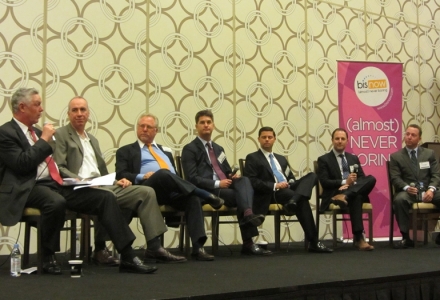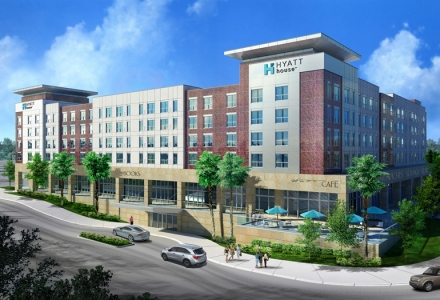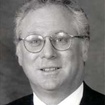
Could it be? At Bisnow’s Construction & Development Summit last week, some bold predictions were made about a traffic-free 10. Read on (and stick around for the also exciting topics of land prices and permitting).
Sonnenblick Development chairman Bob Sonnenblick says the day the Expo Line extension opens, the eastbound 10 Freeway, which becomes bumper-to-bumper at 2pm, will be a totally different place. He also says the dissolution of California’s redevelopment agencies probably cost the industry $4B; all the cities had major projects lined up with RDAs, he says.

He also says the dissolution of California’s redevelopment agencies probably cost the industry $4B; all the cities had major projects lined up with RDAs, he says.
Bob’s a big proponent of design-build because, if well documented, it takes all the construction risk off of the developer’s shoulders. He says development is already hard enough: “If you can take that risk and lay it off on your contractor, it’s got to be the right way to do this thing.” Andy notes Hensel Phelps is budgeting projects it first saw seven to nine years ago, though “they’ve traded who’s actually going to do ’em a couple times.”

Read the complete followup here.

APRIL 22, 2014
Square Feet
By JULIE CRESWELL
In hotels these days, it’s the haves versus the have-nots.
At some dining rooms, guests have to produce their room keys to eat at the
free breakfast buffet. No eggs and muffins for those staying in rooms with other
keys, even if the guests slept under the same roof.
At Chicago’s so-called triplex — where three hotel companies share space on
a city block — Starwood’s Aloft guests work out in a small gym within eyesight of
a much larger one shared by Marriott and Hyatt hotel guests.
“Starwood had an issue, they didn’t want their guests intermingling with the
other guests in the fitness area,” said Deno Yiankes, the head of investments and
development for White Lodging, which codeveloped and operates the Chicago
triplex. “Each brand has its own little hot button. Marriott and Hyatt said it
wasn’t a big deal, so they shared and got a bigger fitness center.”
Juggling those competing little hot buttons is one challenge developers face
as they put up more and more hotels housing two or more brands in the same
building.
Early this year, Marriott opened a hotel in Midtown Manhattan. The lower
half is a Courtyard by Marriott, the upper floors are the Residence Inn,
Marriott’s extended-stay brand. The Hyatt Hotels Corporation has two dualbranded
hotels and at least four more in the pipeline. Hilton, which already has
15 dual-branded hotels in North America, has 17 more approved or under
construction.
“It’s all the rage,” says Craig Mance, a senior vice president for development,
North America, at Hilton Worldwide. A hotel being remodeled on Chicago’s
Magnificent Mile will be split between its Hampton Inn brand while others will
belong to its Homewood Suites brand. Mixed together. On the same floor.
So even as hospitality corporations spend millions of dollars each year to
create distinct brands and experiences they hope will attract repeat customers,
the lines between brands are being blurred by the economics of higher land
prices.
Developers, trying to get the most out of high-priced downtown
metropolitan areas, are searching for ways to slash construction costs and get as
many rooms onto sites as possible.
That’s easier to do with two hotels that can share a pool, exercise room,
conference centers, laundry and kitchens. Those are all areas that take up space,
reducing the number of available rooms. The move reduces operating costs, too.
“There are huge efficiencies to be gained by making the little sandwiches and
putting them in the fridge at the limited-service hotel, running a bar at a
medium-service hotel, and a full bar and restaurant at another, all being run out
of the same kitchen,” said David Kessler, the national director of the commercial
real estate industry practice at CohnReznick, a consulting firm.
And although some hotel companies are embracing dual-branding, they are
struggling over how to maintain their separate identities and how to deal with
the awkward logistics that can arise, like free breakfasts for some hotel guests
but not others.
Brands become particularly wary when it comes to mixing hotels from
different corporations.
Chicago’s triplex opened just last year with three hoteliers sharing some
spaces, like laundry and meeting areas, but keeping other areas, like the gyms, as
well as entrances and lobbies, separate.
Others see more difficulties ahead.
“I think that project is crazy — like crazy bad,” argues Robert Sonnenblick, a
real estate developer who constructs hotels and resorts. “They put in hotels from three big reservations systems, all at the same price point, so that they’re all competing with each other on price. Consumers are going to rate-shop the three of them and choose the lowest one. It’s a race down to zero for the three competing hotels.”
A look at prices on the three corporations’ websites for a king-size bed at the
triplex on the same day in April showed they were within $10 of one another.
White Lodging argues that hotel prices for competing brands in urban
settings tend to be close, whether the hotels are on the same block or across the
street from one another. And executives at Hyatt say the experience has provided
a real-time measure of how they stack up against the competition.
“Once in a blue moon, you’ll see people from the neighboring hotel. But we
still call our lobby the gallery, and we have gallery hosts who will check you in
and pour you a glass of wine,” says Chris Walker, a vice president for Hyatt Place
and Hyatt House brands. “It’s paramount to us that we have control over the
lobby experience.”
Mr. Walker and others in the hotel industry say there are tensions and
continuing debate over what elements are important and make up the total
brand experience for the customer when considering combination developments.
“The purist in me says I don’t want to give up anything. For it to be the Hyatt
experience, it has to be 100 percent. But I’m also a realist and know that that
stance would dramatically eliminate a number of projects that the development
team could pursue,” Mr. Walker says.
Indeed, developers say this is the future.
Developers of the Arundel Mills property in Baltimore put in 150 Hilton
Garden Inn rooms and 100 extended-stay Homewood Suites.
“We got all of the efficiencies of running the property with single
housekeeping, one laundry, and amenities are also shared like the pool, fitness
center and guest laundry,” says David B. Pollin, a co-founder of the
Buccini/Pollin Group, which built and operates the site. “Plus, these two brands
attract two different types of travelers.”
If one brand is full, Mr. Pollin adds, the group has the option to “upgrade”
the traveler to the other.
But breakfast can be tricky. “The Hilton Garden Inn guests are very smart
and try to sneak in for the free breakfast available at the Homewood Suites,”
acknowledges Mr. Pollin, who says hotel staff members try to check guest keys.
Still, hospitality executives generally don’t expect many luxury properties to
jump into the mix because the guest expectations vary widely.
“If you’re used to getting misted at the pool, whether it’s a Waldorf or a Ritz,
and Mr. and Mrs. Smith with their 11 kids who are staying at the Hampton Inn
suddenly jump in, well, that’s not the kind of misting that they want,” says Mr.
Mance of Hilton. “I could see some conflicts arising out of that.”
A version of this article appears in print on April 23, 2014, on page B1 of the New York edition with the
headline: Hotel Brands Doubling Up in Cities Where Space Is Tight.
© 2014 The New York Times Company

April 17, 2014

November will be an especially busy month for Sonnenblick Development’s hospitality activities. Chairman Bob Sonnenblick (at the 7th Hole at Pebble Beach) tells us he’s just finishing design and has put financing down for a $75M Hyatt House on the campus of the USC Medical Center; groundbreaking is slated for Nov. 1. Also getting started that month: a $40M Hyatt Place in the new terminal building at Sacramento International Airport. He’s got other hotels in the works in Palm Springs and in Pinehurst, NC, where a $150M, 330-room Westin Hotel will boast two golf courses.

With 200 rooms and suites, and surrounded by four hospitals, the USC Hyatt House just east of Downtown will cater to patients and their family members. (As long as your continental breakfast is better than the hospital food, you’re on the right track.) In addition, Bob’s searching up and down the SoCal coast for waterfront hotel sites; but there isn’t much oceanfront left. He’s not deterred, though. He’s involved on projects on the waterfronts in Seattle and Palm Beach, Fla., and makes time to go up to Pebble Beach once a month to golf and get inspiration on the 17-Mile Drive. We hope you’ll join us for our LA Construction & Development Summit, April 24 at the JW Marriott at LA Live.









 David Spoont
David Spoont Michael Girimonti
Michael Girimonti Bob Sonnenblick
Bob Sonnenblick